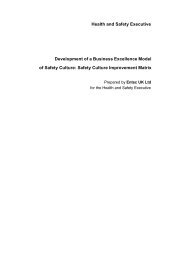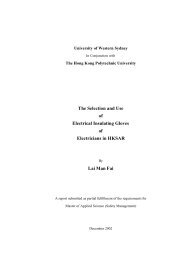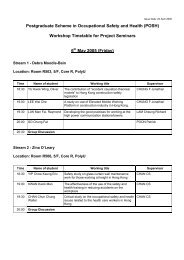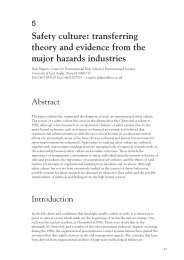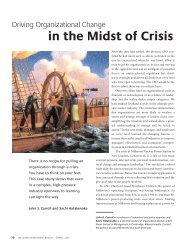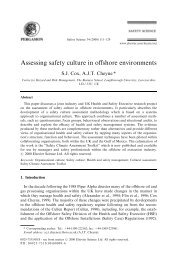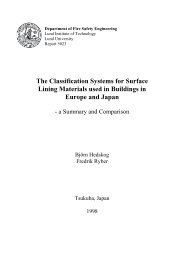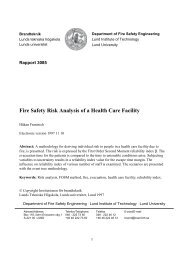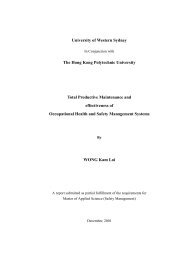An assessment of risk and safety in civil aviation - Industrial Centre
An assessment of risk and safety in civil aviation - Industrial Centre
An assessment of risk and safety in civil aviation - Industrial Centre
You also want an ePaper? Increase the reach of your titles
YUMPU automatically turns print PDFs into web optimized ePapers that Google loves.
46 M. Janic / Journal <strong>of</strong> Air Transport Management 6 (2000) 43}50<br />
could save the aircraft despite severe ic<strong>in</strong>g (Owen,<br />
1998).<br />
Strictly, mechanical failures result from human errors<br />
made whilst construct<strong>in</strong>g, produc<strong>in</strong>g <strong>and</strong> ma<strong>in</strong>ta<strong>in</strong><strong>in</strong>g<br />
the equipment. Such errors can accelerate metal fatigue<br />
<strong>and</strong> other failures <strong>in</strong> aircraft components. The<br />
crashes <strong>of</strong> Comets are one example (Owen, 1998) <strong>and</strong><br />
another was the problem <strong>of</strong> an Aloha Airl<strong>in</strong>es B737 <strong>in</strong><br />
1988 when the aircraft suddenly lost part <strong>of</strong> its cab<strong>in</strong><br />
ro<strong>of</strong> <strong>and</strong> sides dur<strong>in</strong>g #ight. In this latter case, <strong>in</strong>vestigators<br />
found the ma<strong>in</strong> cause <strong>of</strong> cab<strong>in</strong> crack was metal<br />
fatigue due to the frequency <strong>of</strong> take-o!s <strong>and</strong> l<strong>and</strong><strong>in</strong>gs<br />
<strong>of</strong> the aircraft <strong>and</strong> corrosion due to frequent #y<strong>in</strong>g <strong>in</strong><br />
salt air. Design problems lead to modi"cations <strong>in</strong><br />
equipment. The ma<strong>in</strong> cause <strong>of</strong> a crash <strong>of</strong> a DC-10 near<br />
Paris <strong>in</strong> 1974 that killed 346 people was weakness <strong>in</strong><br />
the aircraft's doors <strong>and</strong> di$culties <strong>in</strong> to check<strong>in</strong>g if<br />
they were closed. The result was stronger <strong>and</strong> better<br />
designed doors. The crash <strong>of</strong> a DC-10 at Chicago <strong>in</strong><br />
1979 happened due to eng<strong>in</strong>e failure. The event resulted<br />
<strong>in</strong> stricter rules <strong>and</strong> procedures cover<strong>in</strong>g eng<strong>in</strong>e<br />
ma<strong>in</strong>tenance <strong>and</strong> a review <strong>of</strong> take-o! speeds (Stewart,<br />
1974).<br />
The root-cause <strong>of</strong> many disasters orig<strong>in</strong>ates <strong>in</strong> ma<strong>in</strong>tenance<br />
workshops <strong>and</strong> <strong>in</strong> the factories where vital<br />
components <strong>and</strong> systems have been produced. <strong>An</strong><br />
example "re on a British Airtours B737 at Manchester<br />
Airport <strong>in</strong> 1985. Thermal fatigue, or weaken<strong>in</strong>g <strong>of</strong> the<br />
metal by constant heat<strong>in</strong>g <strong>and</strong> cool<strong>in</strong>g dur<strong>in</strong>g an eng<strong>in</strong>e's<br />
life produced a crack <strong>in</strong> the combustion dur<strong>in</strong>g<br />
the take-o!. The section separated from the eng<strong>in</strong>e <strong>and</strong><br />
hit the port w<strong>in</strong>g fuel tank spill<strong>in</strong>g <strong>of</strong> fuel on a hot<br />
eng<strong>in</strong>e. Subsequently, cracks were found <strong>in</strong> other eng<strong>in</strong>es<br />
<strong>of</strong> this type (Owen, 1998).<br />
Hazardous weather such as thunderstorms <strong>and</strong> frontal<br />
systems can cause troublesome w<strong>in</strong>ds, ra<strong>in</strong>, snow,<br />
fog, <strong>and</strong> low ceil<strong>in</strong>gs that may pose <strong>safety</strong> concerns<br />
at all stages <strong>of</strong> a #ight. In particular, strong w<strong>in</strong>dshear<br />
develop<strong>in</strong>g near airports can make #y<strong>in</strong>g<br />
di$cult because <strong>of</strong> its rapid change <strong>in</strong> speed <strong>and</strong> direction<br />
<strong>and</strong> because <strong>of</strong> a loss <strong>of</strong> lift <strong>in</strong> certa<strong>in</strong> conditions.<br />
The crash <strong>of</strong> an Eastern Airl<strong>in</strong>es B727 dur<strong>in</strong>g<br />
approach at New York's Kennedy Airport <strong>in</strong> June<br />
1975 o!ers a case study <strong>of</strong> the dangers <strong>in</strong>volved.<br />
Dur<strong>in</strong>g the period 1970}1987 the US National Transportation<br />
Safety Board identi"ed low-altitude w<strong>in</strong>d<br />
shear as the factor caus<strong>in</strong>g or contribut<strong>in</strong>g to 18 commercial<br />
aircraft accidents; seven were fatal result<strong>in</strong>g <strong>in</strong><br />
the loss <strong>of</strong> 575 lives. The development <strong>of</strong> sophisticated<br />
This example illustrates the importance <strong>of</strong> experience <strong>and</strong> tra<strong>in</strong><strong>in</strong>g<br />
<strong>in</strong> reduc<strong>in</strong>g the probability <strong>of</strong> an accident (Kuhlmann, 1981). However,<br />
education <strong>and</strong> tra<strong>in</strong><strong>in</strong>g <strong>of</strong> <strong>aviation</strong> sta! is expensive which poses problems<br />
at time when airl<strong>in</strong>es are under pressure to control costs (Dose,<br />
1995).<br />
weather report<strong>in</strong>g, forecast<strong>in</strong>g <strong>and</strong> detect<strong>in</strong>g systems,<br />
onboard <strong>and</strong> ground-based, have reduced this type <strong>of</strong><br />
threat.<br />
Terrorist actions are highly correlated with political<br />
<strong>and</strong> economic tensions <strong>in</strong> the world. A typical example<br />
was the crash <strong>of</strong> a B747 on 23 June 1985 due to<br />
a suspected bomb explosion. After the crash security<br />
measures at high <strong>risk</strong> airports were strengthened.<br />
Such acts have also <strong>in</strong>itiated the <strong>in</strong>troduction <strong>of</strong> new<br />
technologies <strong>and</strong> security procedures that are <strong>in</strong>tended<br />
to prevent an illegal entry onto the aircraft <strong>and</strong> to<br />
detect the presence <strong>of</strong> weapons be<strong>in</strong>g taken onboard.<br />
(Rosenberg, 1987).<br />
Military <strong>and</strong> semi-military operations have also resulted<br />
<strong>in</strong> accidents. One example was the crash <strong>of</strong><br />
a Korean B-747 over Sakhal<strong>in</strong> Inl<strong>and</strong> kill<strong>in</strong>g 269<br />
people. Due to navigational error the aircraft<br />
deviated from its prescribed course <strong>and</strong> entered<br />
Soviet airspace <strong>and</strong> #ew over a prohibited area.<br />
After several warn<strong>in</strong>gs, the aircraft was shot down by<br />
a Soviet missile. The event stimulated improved coord<strong>in</strong>ation<br />
<strong>of</strong> <strong>civil</strong> <strong>and</strong> military <strong>aviation</strong> (Stewart,<br />
1994).<br />
Human errors can be reduced by tra<strong>in</strong><strong>in</strong>g <strong>and</strong> the<br />
structur<strong>in</strong>g <strong>of</strong> air tra$c patterns so as to avoid excess<br />
stress. Factors such as hazardous weather, mechanical<br />
faults, sabotages <strong>and</strong> military operations would seem to<br />
be more r<strong>and</strong>om <strong>and</strong> less easily dealt with. This does not<br />
mean the system is unsafe. Safety should be considered<br />
with respect to the base causes <strong>of</strong> accidents. If accidents<br />
occur due to known <strong>and</strong> avoidable factors, the system<br />
should be considered as unsafe. Otherwise, if accidents<br />
occur for unknown <strong>and</strong> unavoidable reasons, the system<br />
should be considered as safe.<br />
4. A methodology for assess<strong>in</strong>g the <strong>risk</strong> <strong>and</strong> <strong>safety</strong><br />
In <strong>civil</strong> <strong>aviation</strong>, <strong>risk</strong> has been assessed as the probability<br />
<strong>of</strong> the occurrence <strong>of</strong> an air accident <strong>in</strong> terms <strong>of</strong> two<br />
aggregate <strong>in</strong>dicators, the accident rate <strong>and</strong> the fatality<br />
rate. The probability <strong>of</strong> an air accident is very low mak<strong>in</strong>g<br />
it a di$cult <strong>and</strong> complex task to properly expla<strong>in</strong>,<br />
locate, <strong>and</strong> manage overall <strong>aviation</strong> <strong>safety</strong>. There is also<br />
the need to consider the impact <strong>of</strong> policy on di!erent<br />
impacted groups such as users, service operators (airl<strong>in</strong>es,<br />
airports, air tra$c control), <strong>aviation</strong> <strong>and</strong> non-<strong>aviation</strong><br />
pr<strong>of</strong>essional <strong>and</strong> non-pr<strong>of</strong>essional organizations <strong>and</strong><br />
public (Kanafani, 1984).<br />
Two approaches for assess<strong>in</strong>g <strong>risk</strong> <strong>and</strong> <strong>safety</strong> are considerd.<br />
The causal approach looks at the number <strong>of</strong><br />
accidents <strong>and</strong> number <strong>of</strong> fatalities, the scale <strong>of</strong> the system's<br />
output dur<strong>in</strong>g a given period <strong>and</strong> other relevant<br />
characteristics that are seen as relevant causal variables.<br />
The number <strong>of</strong> accidents, deaths <strong>and</strong> <strong>in</strong>juries per unit <strong>of</strong>




